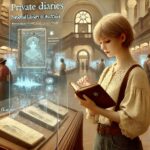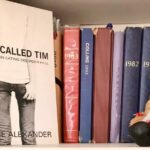Short life stories and a magic carpet ride
Short life stories and a magic carpet ride
I was glad to have a vacant seat beside me on the long Qantas flight to New York. It gave more room to spread myself out. Other passengers were absorbed in watching movies on the little screens in front of them, but I had work to do – a feast of short stories to read.
I reached down and pulled up my well-travelled, grubby but much-loved Barnes & Noble book bag from under the seat in front, and from it took a pen and a bulging, bright orange manila folder.
Unclicking the meal tray to use as a desk, I opened the folder and held in my hands an A4 size bundle of pages – containing the stories from a recent workshop that would soon appear in a printed book, to be shared with all participants, and many others as well, for this book would be placed on the shelves of the local public library.
I was both euphorically and literally, up in the air.
Thinking about it, this was an ideal place to be. As soon as I began reading the stories and poems, I started to feel up in the air in an entirely new way, not because I was on the plane, but because the stories were taking me on a magic carpet ride, not to a conference in New York, but back to my childhood in country Victoria and many other places besides.
This brings me to the crux of life writing – why I find it eternally exciting: either by writing our own story or by reading that of somebody else, we get treated to one adventure after another.
As the writer, we are the pilot and navigator of our own story. Our choice of words maps our journey and destination. Memories and imagination are our fuel.
Our pen races and paces as we duck-dive into the past to pick up thoughts and feelings, take them on board and preserve them in stories for future generations.
Our soul is our creative engine and writing is one of the best ways to keep it cleansed and primed, enabling us to reach great heights of contentment on our life journey. When we connect with our soul, we can write without fear, cruise confidently and candidly, through both calm and stormy weather.
So the contributors of the stories I held in my hands on the flight to New York had sat at home, at some time in the past year, in their favorite writing place, with pen and paper in hand, or keyboard, and probably a cup of tea or coffee on the side, writing their story that was now about to be published.
How exciting is that!
Like you, I am what our society labels ‘an older person’. Many of your memories are shades of my memories, too. Even though we have not yet met, our journeys through life occasionally have shared the same path. By some miracle we are born; we have a childhood; we emerge into adulthood; at some stage, early for some, later for others, we fly or perhaps fall or are pushed, from the family nest; from there, we proceed to spread our wings.
Along the way, we gather experiences which, combined with our genetic makeup and personality traits, make us who we are today.
Every person has their own story, and this is why I encourage people to take up life writing. Nobody can tell your story better than you. Life writing requires connecting with our memories and feelings to write creatively about something that may or may not have happened – remember, you are the captain of your own perceptions in life. Even when we are the same age, and share the same experience, our stories may be entirely different, and yet we are both right.
Writing enables us to remind ourselves and perhaps others, that we, indeed, have had a life: a purposeful and meaningful life. We cannot tell all this by looking at a photograph. To bring it to life, we need to write.
Creative writing also allows our imagination to heal old wounds. If we have had a painful experience, we can write about it in a way that enables us to repackage it, lighten our load and produce a happier ending.
By writing a life story, no matter how fanciful, we are preserving part of our true self too.
So, the writers have completed their stories, and the poets, their poems. Their book has been published.
My role as life writing mentor involves offering encouragement and guidance and helping each story-teller to add that extra shine, so that their work flows well, keeps the reader’s attention, and employs structure, description and narrative skills to take the reader to another place.





